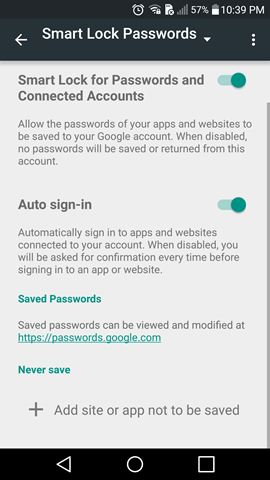

- #Google smart lock passwords manual#
- #Google smart lock passwords full#
- #Google smart lock passwords for android#
You'll obviously want to be selective about what places you choose, but configuring this to recognize somewhere like your home can be a helpful way to avoid authentication where it's generally not needed but keep your phone secured in all other areas.
#Google smart lock passwords manual#
Trusted places: Perhaps the most useful Google Smart Lock element, this option allows you to set specific locations - by business name, street address, or manual map placement - at which your phone will never put up a lock screen or require authentication (in theory, at least the function can sometimes be a bit finicky and require occasional fine-tuning).

Anytime your phone is set down or not in motion for more than a moment, it'll require authentication again. That way, if you unlock your phone to use it and then put it back into your bag or pocket while walking around, you won't have to unlock it again the next time you pick it up. On-body detection: Fire up this option, and your phone will remain unlocked whenever you're holding or carrying it - so long as you've already unlocked it once.

However you get there, once you've opened the Smart Lock section, you'll be prompted to put in your PIN, pattern, or password - and you'll then see a list of available choices: Open the Lock Screen section of your phone's settings.On Android phones where the manufacturer has made modifications to the operating system, the Smart Lock section may be located in a different area of the device's settings. On more current and up-to-date devices, tap "Advanced settings" and then tap "Smart Lock.".On older Android versions, tap "Smart Lock.".Open the Security section of your phone's settings.Then, in the standard Google Android setup - the setup you see on Pixel phones and certain other devices: To activate Google Smart Lock on Android, you'll first need to have a PIN, pattern, or password set for your phone (which you should already have, regardless!). It's the best of both worlds, in other words: effective Android security without unnecessary annoyances. On any reasonably recent Android device, you can set up Google Smart Lock to keep your phone unlocked in certain trusted situations but to require your PIN, pattern, password, or biometric authentication at all other times.
#Google smart lock passwords full#
Here's a step-by-step guide to activating Google Smart Lock and taking full advantage of everything it has to offer across both Android and ChromeOS. And best of all? Once you set it up in either environment, it couldn't be much easier to use. In ChromeOS, it empowers your Android phone to keep your computer unlocked. In Android, the system allows you to keep your phone unlocked in certain preapproved, known-to-be-safe circumstances.
#Google smart lock passwords for android#
But now the app knows the users google or twitter account ? Here is the code im talking about: private void onCredentialRetrieved(Credential credential) else if (accountType.equals(IdentityProviders.Google Smart Lock is an unlocking feature for Android devices and Chromebooks. I was wondering if there is a security issue here ? Any app who uses the google smart lock will know the users google,twitter, etc account credentials right ? take a look at this google tutorial here and in the credentialsRetrieved call back the Credential object has the users user name and password which the app can access.


 0 kommentar(er)
0 kommentar(er)
